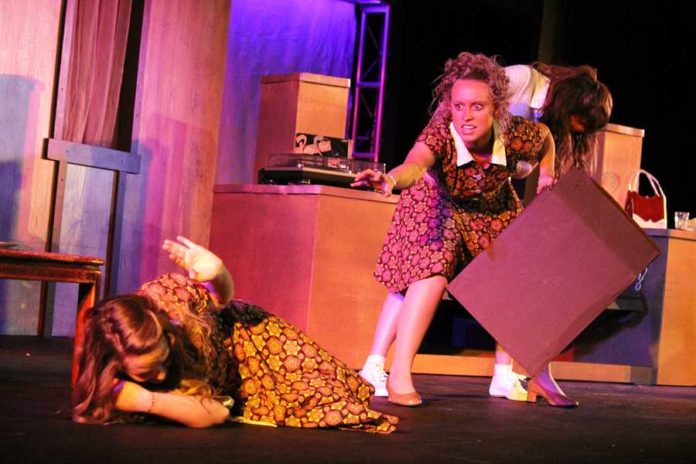The Slippery Rock Department of Theatre brought James McLure’s companion plays “Laundry and Bourbon” and “Lone Star” to the stage this week, but it didn’t get there without some difficulty.
“Laundry and Bourbon” and “Lone Star” are both one-scene plays taking on two perspectives of the same story. Both take place in rural Texas and focus on the dynamic relationship of married high school sweethearts, Elizabeth and Roy, who can’t move on from the glory days of their past and into their less-than-glorious present.
Director Dr. David Skeele brought “Laundry and Bourbon” and “Lone Star” to the stage after the good response his students had to the plays in his acting class. He said that among themes of war, relationships, and religion, the prominent theme of “Laundry and Bourbon” and “Lone Star” is the crippling effect nostalgia has on people and their relationships.
In “Laundry and Bourbon,” Elizabeth waits on her porch for her husband, Roy, to come home in the pink Mustang convertible that he’s had since high school. She explains to her best friend Hattie that she tolerates Roy’s flighty nature because of how he used to make her feel when they were dating. In “Lone Star,” we see a drunken Roy at Angel’s bar reflecting on his glory days of high school after someone wrecked his infamous convertible.
“Nostalgia has a very toxic effect on people,” Skeele said. “People try so hard to relive the glory days of their past, that it destroys their perception of the present.”
Skeele said the biggest struggle of directing the plays was the unexpected illness of the original actor who was supposed to play Roy. Four days before the show, Skeele asked Ethan Rochow to step in for the role of Roy.
Rochow, an acting major, 24, said that when he was approached for the role, he devoted any time he could to memorizing lines.
“I just kept saying to myself, ‘oh my God, I don’t know if I can do this,’” he laughed. “When the time came, it just went, and it was great.”
Stage manager Kyle Andreas, theatre design and technology major, 21, faced the challenge of the entire set being redesigned for safety issues. Andreas said that one of the main issues with the redesign was that the actors had to wait a week for the set to be finished, and they didn’t get as much practice with the set as they could have.
Skeele said the plays, which originally aired in 1979, have controversial themes that playwrights today couldn’t get away with, including the use of racial slurs, and the comic portrayal of the effects of post-traumatic stress disorder.
“I think the trick to using these sensitive subjects in a way that isn’t offensive is to create characters who are so sympathetic and innocent that you don’t focus on the darker parts of their character,” Skeele said.
Rochow said that Roy was his favorite character he has ever played because of the creative freedom that he had in portraying drunkenness. The drunken scenes between Roy and his younger brother, Ray, were very well received by the audience and got a lot of laughs. This was especially true when Roy requested Ray’s help in reenacting his missions in Vietnam.
“Ray is my favorite character in ‘Lone Star’ because, though he is an adult, he sees the world through child’s eyes,” Skeele said. “Even when he reveals his infidelity with his brother’s wife, you can tell it came from a very innocent place.”
The audience also responded well to Kaitlin Cliber’s portrayal of Elizabeth’s best friend, and mother of three, Hattie in “Laundry and Bourbon.” Rochow said that Hattie was his favorite character because of her over-dramatized persona.
“The hardest part of directing is making your audience understand your characters and their relationships,” Skeele said. “The cast barely broke a sweat in achieving those relationships, and were very believable.”







